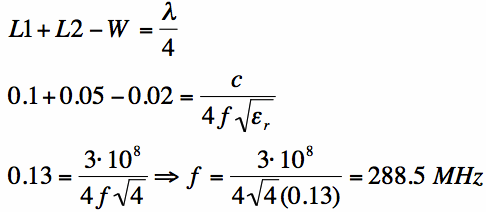PIFA - The Planar Inverted-F Antenna
|
Antenna designers are always looking for creative ways to improve performance. One method used in patch antenna design is to introduce shorting pins (from the patch to the ground plane) at various locations. To illustrate how this may help, two instances will be illustrated, the quarter-wavelength Patch Antenna, which leads into the Planar Inverted-F Antenna (PIFA).
Quarter-Wavelength PatchA quarter-wavelength patch shorted at the far end is shown Figure 1.
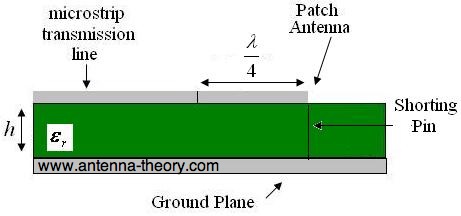 Figure 1. Quarter-wavelength patch with shorting pin at end. Because the patch is shorted at the end, the current at the end of the patch antenna is no longer forced to be zero. As a result, this antenna actually has the same current-voltage distribution as a half-wave patch antenna. However, the fringing fields which are responsible for radiation are shorted on the far end, so only the fields nearest the transmission line radiate. Consequently, the antenna gain is reduced, but the patch antenna maintains the same basic properties as a half-wavelength patch, but is reduced in size 50%.
Shorting Pin At the Feed to a Patch AntennaA shorting pin can also be used at the feed to a patch antenna, as shown in Figure 2.
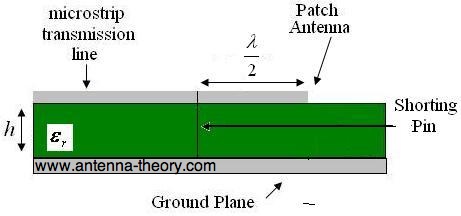 Figure 2. Half-wavelength patch with shorting pin at the feed. You may be tempted to think that the shorting pin would zero out any power delivered to the antenna. However, because patches are high frequency devices (typically used at >1 GHz), the shorting pin actually introduces a parallel inductance to the antenna impedance. The equivalent circuit of the above antenna is shown in Figure 3. The antenna impedance is given by ZA, and the shorting pin introduces a reactance equal to jX.
 Figure 3. Equivalent Circuit of antenna in Figure 2. The affect of the parallel inductance shifts the resonant frequency of the antenna. In particular, the two components in parallel would result in their admittances (Y=1/Z) adding. Hence, the admittance of the patch has a 1/(jX) added to it. In this manner, the resonant frequency can be altered. In addition, the shorting pin can become capacitive if instead of extending all the way to the ground plane, it is left floating a small amount above. This introduces another design parameter to optimize performance.
Planar Inverted F-Antenna (PIFA)
The Planar Inverted-F antenna (PIFA) is increasingly used in the mobile phone market. The antenna is resonant at a quarter-wavelength (thus reducing the required space needed on the phone), and also typically has good SAR properties. This antenna resembles an inverted F, which explains the PIFA name. The Planar Inverted-F Antenna is popular because it has a low profile and an omnidirectional pattern. The PIFA is shown from a side view in Figure 4.
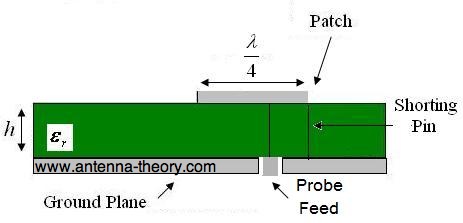 Figure 4. The Planar Inverted-F Antenna (PIFA).
The PIFA is resonant at a quarter-wavelength due to the shorting pin at the end. We'll see how the resonant length is defined exactly in a minute. The feed is placed between the open and shorted end, and the position controls the input impedance. In PIFAs, the shorting pin can be a plate, as shown in Figure 5:
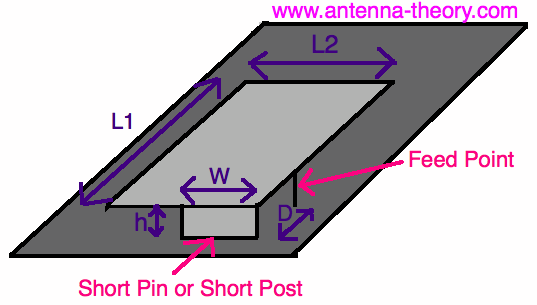 Figure 5. The Planar Inverted-F Antenna (PIFA), with a shorting Plane.
In Figure 5, we have a PIFA of length L1, of width L2. The shorting pin (or shorting post) is
of width W, and begins at one edge of the PIFA as shown in Figure 5. The feed point is along the same
edge as shown. The feed is a distance D from the shorting pin. The PIFA is at a height h from
the ground plane. The PIFA sits on top of a dielectric with permittivity
The impedance of the PIFA can be controlled via the distance of the feed to the short pin (D). The closer the feed is to the shorting pin, the impedance will decrease; the impedance can be increased by moving it farther from the short edge. The PIFA can have it's impedance tuned with this parameter.
The resonant frequency of the PIFA depends on W. If W=L2, then the shorting pin runs the entire width of the patch. In this case, the PIFA is resonant (has maximum radiation efficiency) when:
Suppose that W=0, so that the short is just a pin (or assume W << L2). Then the PIFA is resonant at:
Why does the resonant length of the PIFA depend on the shorting pin length W? Intuitively, think about how a quarter-wavelength patch antenna radiates. It needs a quarter-wavelength of space between the edge and the shorting area. If W=L2, then the distance from one edge to the short is simply L1, which gives us Equation [1]. What about when W=0? Since it is the fringing fields along the edge that give rise to radiation in microstrip antennas, we see that the length from the open-circuited radiating edge (the far edge in Figure 5) to the shorting pin is on average equal to L1+L2. You can convince yourself of this by measuring the distance from any point on the far edge of the PIFA to the shorting pin. The clockwise and counter-clockwise paths always add up to 2*(L1+L2), so on average, resonance will occur when the path length (L1+L2) for a single path is a quarter-wavelength. In general, we can approximate the resonant length of a PIFA as a function of it's parameters as:
To make things concrete, suppose L1=0.1 meters (10cm), L2=0.05 meters (5 cm), W=0.02 meters (2cm), and that
In Equation [4], note that we used one of the fundamental antenna equations, relating wavelength, speed of light and permittivity:
Capacitive Loading in PIFA AntennasSuppose we want to further reduce the length of our pifa antenna. What can we do? Well, it's common to use capacitive loading in PIFA antennas. In this technique, we add capacitance to to the PIFA antenna, between the feed point and the open edge. This is illustrated in Figure 6:
 Figure 6. Capacitive Loading in Planar Inverted-F Antenna (PIFA). Why does this work? Well, to the right of the feed in Figure 6, we have a short circuit to ground. Short circuits with a small fraction of a wavelength can be viewed as a parallel inductance to ground, as far as the impedance is concerned. Similary, the open circuit and arm to the left of the feed in Figure 6 can be viewed as a capacitor (if this isn't too clear, you might want to check out the transmission line tutorial). The distances from the feed to the shorting pin, or the feed to the open edge of the PIFA determine the inductance and capacitance, respectively. In some sense, the lengths are required such that the inductance and capacitance can be balanced out.
Hence, if we shorten up the length of the PIFA, we lose some of the capacitance to the left of the feed in Figure 6. To compensate for this, we add a parallel capacitance, and (from an impedance perspective), everything remains balanced and the PIFA radiates.
This technique works, but be careful: you lose radiation efficiency by using this technique (and the bandwidth of your PIFA will decrease as well). You can't just decrease the size of your PIFA, replace it with capacitance and expect everything to be the same: you can't get something for nothing; antenna engineering is all about trade-offs.
PIFAS in the Real World
The Samsung Galaxy S is an android smartphone that works on CDMA networks in the US. This means the frequency will be 850 and 1900 MHz, requiring one transmit/receive antenna and one receive-only antenna (known as a diversity antenna). The phone's antennas have been shown in an FCC report, shown below:
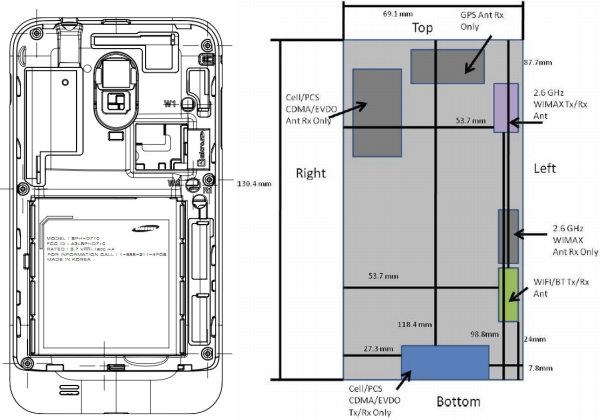 Figure 7. The antenna types and locations on the Samsung Galaxy S. The phone has 6 antennas, as shown in Figure 7. The Tx/Rx cellular antenna is the blue square at the bottom and the diversity cellular antenna is in the upper left region. The GPS antenna (1.575 GHz) is on the top, and the WIFI antenna (which is dual band according to the FCC report, operating at 2.4 GHz and 5 GHz) is the green square on the lower right side. This phone also has WiMax antennas (operating at 2.6 GHz), one for Tx/Rx and another as a diversity (Rx only) antenna. These antennas are PIFAs. There is a single large ground plane that supports the circuit board and touch screen, and this is the ground plane for all the antennas. It is important to note that even though the FCC report labels the specific regions as the antennas, the entire ground plane (i.e. the entire phone) makes up the antenna. That is - if you cut away the ground plane the phone would not radiate well at the lowband 850 MHz (where the half-wavelength is 6" or 17 cm). In addition, the SAR report for this phone gives a very low value for peak SAR, equal to 0.402 W/kg averaged over 1g of tissue (the FCC limit to sell a phone in the US is 1.6 W/kg). This is an advantageous property of PIFAs: since the radiation is away from the ground plane (towards the rear of the phone), the energy is directed away from the head, giving a low value for SAR.
Video: PIFA Analysis
The PIFA is explained via a lecture in the following video, which rehashes the above discussion in a different form:
|
 as with the patch antenna.
as with the patch antenna.


